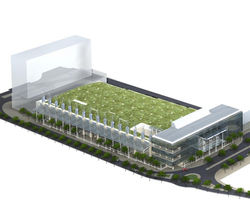VAN DER MERWE MISZEWSKI ARCHITECTS
 |  |  |  |  |  |  |
|---|---|---|---|---|---|---|
 |  |  |  |  |  |  |
 |  |  |  |  |
C T I C C
N O R T H E X T E N S I O N
Cape Town International Convention Centre North Extension Proposal
2008
Extension options for CTICC1 were first studied by the architects in 2000, the year that the designs for CTICC1 commenced. From the outset it was pointed out by the Operator that the 10 000m2 that could be accommodated on the current site would not satisfactorily deal with future growth opportunities. Two adjacent sites, to the North and the East were examined, and the “Customs House” site was finally selected as the preferred site for the first proposed extension.
A significant shift in the client brief for this extension was the inclusion of a “green” or sustainability component, to achieve a level that would be competitive internationally. In order to lend the intended green status credibility, it was necessary for the project to be rated in terms of an internationally recognised system. To this end it was agreed to provisionally adopt the Australian Green Star System until the South African system was fully established (now SAGBC), and to aim is for its highest 6 star rating which equates to ‘World Excellence’ status.
CTICC 1 was designed as an urban building that filled its site and extended wherever possible to the pavement line. It is the antithesis of an object building. An ‘urban room or court’ was created at the main entrance foyer and is now known as Convention Square. This square has become an important and pivotal court in the overall city fabric, and provides an opportunity for civic functions and a sense of occasion upon arrival. The extension of this square towards the new CTICC2 Foyer entry will be heavily landscaped to create a series of inter-connecting urban courts. From this new Foyer, the new concourse completes a U-shaped circulation spine which surrounds the inner marshalling yard, and faces towards the active working harbour edge of the city. Its proposed cafes and many outdoor activities will provide for a range of lively street activities.
The building character is seen as an extension of the CTICC1 palette, with transparency and accessibility still a binding philosophy in the design. Selected elements of the sustainability agenda have become feature elements in the building, most notably the wind turbine towers, the insulating green roof and the photovoltaic sun screening.
The many green elements and strategies in the building - including energy harvesting (turbines and Photovoltaic panels), black water treatment, sun screening, double glazing, water capture, natural ventilation, sunlight capture, insulation – all contribute to 40% less energy consumption per m2, 95% less potable water consumption and 25% less waste to landfill.
Project in association with Foreshore Architects.
View completed 'CTICC' project
_______________________________
CREDITS
_______________________________
_______________________________
_______________________________
PROJECT PDF ›
_______________________________
SHARE THIS PROJECT
_______________________________